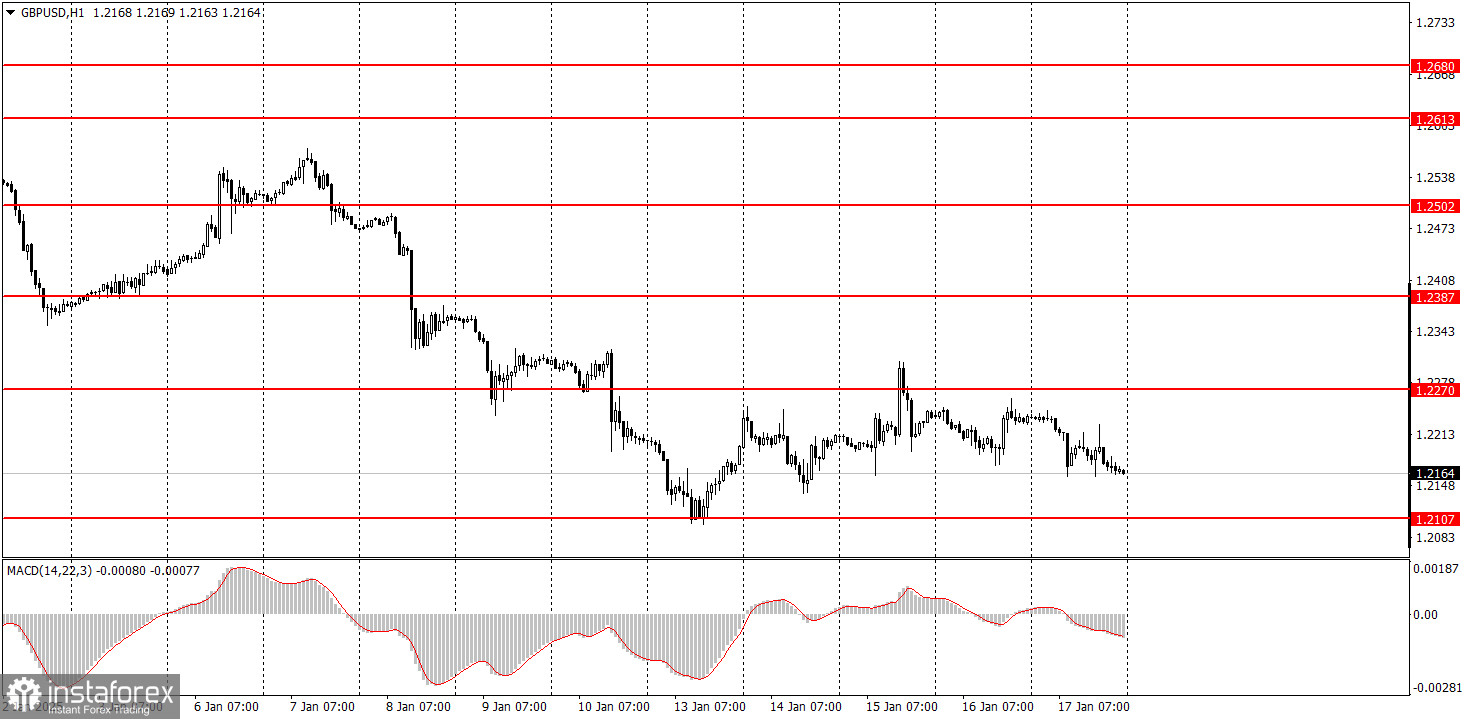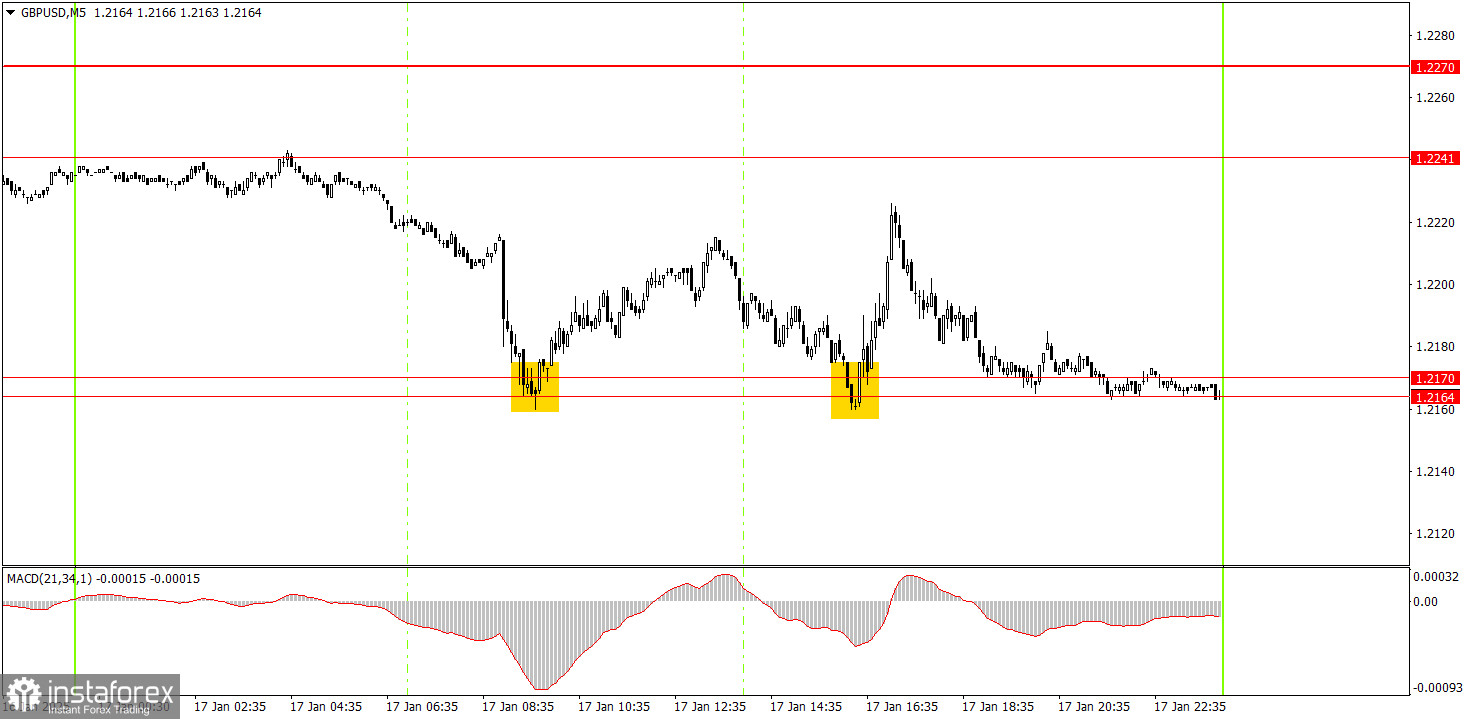Analysis of Friday's Trades
1H Chart of GBP/USD

The GBP/USD pair continued to trade within a local horizontal channel on Friday. However, the market activity we observed this week cannot be classified as flat. The price tested the 1.2107 level, rebounded from it, made a minimal correction, and then gradually reversed downward, continuing its decline. For a true flat market to be established, a third point of reference is necessary. If the price fails to break below the 1.2107 level in a second consecutive attempt, the pair could remain in this horizontal channel for an extended period.
This week, the British pound had several reasons to resume its decline. Two inflation reports (from the US and the UK), the GDP report, retail sales data, and industrial production figures all highlighted the weakness of the UK economy or indicated a hawkish stance from the Federal Reserve. As a result, the pound managed only a nominal correction and is now set to decline further. We see no reasons for the British currency to rise at this time.
5M Chart of GBP/USD

On the 5-minute timeframe, Friday offered two buy signals similar to those seen with the EUR/USD pair. The price bounced back twice from the 1.2164-1.2170 range, and in both instances, it rose significantly. As a result, novice traders had two opportunities to enter long positions, with each trade potentially generating a small profit. The macroeconomic environment on Friday continued to favor the US dollar, making it surprising that the 1.2164-1.2170 zone was not breached.
Trading Strategy for Monday:
On the hourly timeframe, GBP/USD continues to show a downtrend. In the medium term, we fully anticipate a decline toward 1.1800 for the pound, as this remains the most logical scenario. Therefore, we expect further declines; however, traders should always rely on technical signals for guidance. This week has indicated that the pound is likely to keep falling, with no significant obstacles in its path.
On Monday, the pair may trade calmly but could break through the 1.2164-1.2170 range, which would trigger a new downward movement.
On the 5-minute timeframe, trading is currently possible at the following levels: 1.2010, 1.2052, 1.2089-1.2107, 1.2164-1.2170, 1.2241-1.2270, 1.2316, 1.2372-1.2387, 1.2445, 1.2502-1.2508, 1.2547, 1.2633, 1.2680-1.2685, 1.2723, and 1.2791-1.2798. There are no significant events or reports scheduled in the UK or the US for Monday. Consequently, strong price movements are unlikely. However, if the price breaks through the 1.2164-1.2170 area, the pound may experience a sharp downward acceleration.
Core Trading System Rules:
- Signal Strength: The shorter the time it takes for a signal to form (a rebound or breakout), the stronger the signal.
- False Signals: If two or more trades near a level result in false signals, subsequent signals from that level should be ignored.
- Flat Markets: In flat conditions, pairs may generate many false signals or none at all. It's better to stop trading at the first signs of a flat market.
- Trading Hours: Open trades between the start of the European session and the middle of the US session, then manually close all trades.
- MACD Signals: On the hourly timeframe, trade MACD signals only during periods of good volatility and a clear trend confirmed by trendlines or trend channels.
- Close Levels: If two levels are too close (5–20 pips apart), treat them as a support or resistance zone.
- Stop Loss: Set a Stop Loss to breakeven after the price moves 20 pips in the desired direction.
Key Chart Elements:
Support and Resistance Levels: These are target levels for opening or closing positions and can also serve as points for placing Take Profit orders.
Red Lines: Channels or trendlines indicating the current trend and the preferred direction for trading.
MACD Indicator (14,22,3): A histogram and signal line used as a supplementary source of trading signals.
Important Events and Reports: Found in the economic calendar, these can heavily influence price movements. Exercise caution or exit the market during their release to avoid sharp reversals.
Forex trading beginners should remember that not every trade will be profitable. Developing a clear strategy and practicing proper money management are essential for long-term trading success.





















